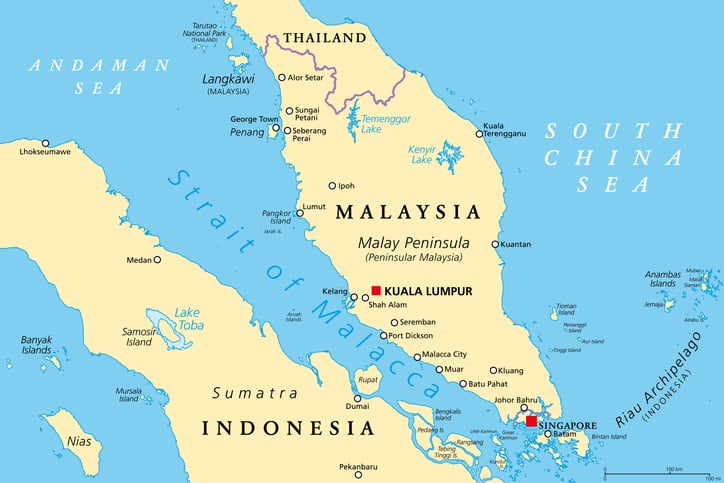The Strait of Malacca’s Global Supply Chain Implications

In today’s interconnected global economy, supply chains are the lifeblood of commerce, enabling goods and services to flow seamlessly across continents. As organizations prioritize efficiency, it becomes increasingly crucial to recognize and consider significant pressure points in these supply chains. One such pivotal point is the Strait of Malacca.
Often overlooked, the Strait of Malacca is a critical gateway between the Pacific and Indian oceans. Located between the Malay Peninsula and the Indonesian island of Sumatra, this narrow stretch of waterway is geographically the shortest path for container and cargo vessels journeying between Europe, the Middle East and Africa on one side and East Asia on the other.
China’s most significant challenge in the Indian Ocean is the “Malacca dilemma.” The Malacca Strait is a crucial maritime chokepoint. The potential of a naval blockade here, by the U.S. or Indian navies, presents Beijing with a serious wartime economic security threat.
This threat has led to China investing in alternative routes, but these have their own sets of challenges, as Lucas Myers, senior associate at the Wilson Center, a Washington, D.C.-based think tank, stated in a Georgetown Journal of International Affairs article in March.
Understand, Adapt and Innovate
The volume of trade that transits through this strait is staggering: US$3.5 trillion of global trade navigates through its waters annually. This includes two-thirds of China’s maritime trade volume, 40 percent of Japan’s maritime trade, and a third of all worldwide trade. Such figures underline its significance: China, for instance, channels about 80 percent of its oil imports through this strait, representing 60 percent of its entire oil supply, according to reports.
These metrics do not merely represent logistical statistics; they symbolize the intertwined nature of global commerce. A potential disruption in the Strait of Malacca would not only impact Asia but would ripple across global supply chains, reflecting the domino effect characteristic of interconnected trade networks.
It is not about pointing out vulnerabilities but rather understanding the intricate webs of global supply chains — and recognizing areas where increased attention could prove beneficial. As the world has seen with events like the coronavirus pandemic and the Russia-Ukraine war, proactive awareness and preparation are paramount.
How can industries bolster their knowledge to react swiftly and effectively to unforeseen challenges? According to insights from Russell Group, a consortium of 24 British universities, it requires more forward-thinking and integrated decision-making. It is about designing resiliency solutions that are adaptive to change, connected to potential threat avenues, and outcome-focused, activated by predefined scenarios.
According to the Russell Group, as industries become more interdependent, corporations hold onto more risk — which could hamper the ability for a timely response.
The next step for global industries, then, is clear: Understand, adapt and innovate. A mix of data, analytics and, most importantly, imagination is needed to architect solutions. Collaborative market endeavors will be the key to unlocking these solutions and ensuring that global supply chains, with all their intricacies, continue to function smoothly.
Supply chains, at their core, are not just about products and routes; they are about foreseeing challenges — and planning and ensuring the world remains as interconnected tomorrow as it is today.
The Western Ripple
What happens in one part of the world can have wide-ranging implications for regions thousands of miles away. With the Strait of Malacca critical to global commerce, its smooth operation is not only pivotal for Asia but also has profound implications for the West. Given the significant volume of trade that passes through the strait, any disruption there can have cascading effects on industries across Europe and North America:
- Automotive industry. China plays a pivotal role in the automotive supply chain, especially in the electric vehicle segment. The U.S. auto industry’s share in economic growth has experienced a decline over the years, dipping from a 4.9 percent share of gross domestic product (GDP) in 1973 to about 3.3 percent in 1990. Yet, as noted in the 2022 Deloitte report, it still contributes to manufacturing’s value-add to the economy, accounting for nearly 7 percent in 2020. Any disruptions in China, which relies heavily on the Strait of Malacca for its trade, could affect the production of essential components, potentially hampering vehicle assembly and sales in the West, the report states.
- Electronics and technologies. From smartphones to laptops, many of the devices we rely on daily have components sourced or are fully manufactured in East Asia. A prolonged disruption in the Strait could lead to shortages in the West, affecting not only tech giants but also consumers awaiting the latest gadget.
- Retail and fashion. The fashion industry, with its intricate web of global suppliers, is particularly vulnerable. Many Western fashion brands source fabrics, garments or accessories from East Asia. Delays could disrupt seasonal releases, with potential stock shortages during peak shopping seasons.
- While the West does not rely as heavily on the Strait of Malacca for its energy needs as East Asian nations do, global oil prices are intricately linked. Any disruption in a major supply route can cause fluctuations in global oil prices, affecting everything from fuel prices at the pump to energy bills at home.
- Many active pharmaceutical ingredients (APIs) originate from Asia. Disruptions could delay the manufacturing of essential medications, leading to potential shortages in Western pharmacies.
- Agriculture and food. Certain specialty food items and ingredients sourced from Asia could see availability issues. While not staples, these disruptions can affect specific sectors of the food industry and limit choices for consumers.
Given these potential ripple effects, it becomes clear that maintaining the open flow of goods through chokepoints like the Strait of Malacca is vital not just for the adjacent countries but for the global community at large.
These challenges also present opportunities for industries and companies to reassess and diversify their supply chains, exploring new partnerships and routes to mitigate potential risks. Additionally, technological advancements, like improved cargo tracking and predictive analytics, can better prepare industries to anticipate and respond to disruptions more effectively.
The Strait of Malacca serves as a reminder of the intricate interdependencies of our modern world. For businesses and policymakers in the West, understanding these dynamics is crucial. While it is essential to be aware of potential vulnerabilities, it is equally vital to view them as catalysts for innovation, collaboration and strategic foresight in our ever-evolving global landscape.


